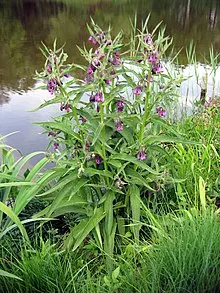Comfrey Uncovered: Your Comprehensive Guide to This Remarkable Plant
1. What Does Comfrey Look Like? A Detailed Exploration
This post provides a detailed description of the comfrey plant, highlighting its distinctive leaves, colorful flowers, robust stems and roots, and impressive size. It notes that comfrey is a plant of many wonders, from its large, green leaves to its bell-shaped flowers, from its sturdy stems to its deep root system. Each aspect of this plant is a testament to the marvels of nature.
2. Why is Comfrey Good for Compost? Understanding the Benefits of this Remarkable Plant
This post explains why comfrey is often referred to as a 'garden's best friend'. It highlights the high nutrient content, quick decomposition, deep root system, disease and pest resistance, and green manure properties of comfrey that make it good for compost. It concludes that understanding what comfrey is and why it is good for compost can revolutionize your approach to organic gardening.
3. Which Comfrey is Medicinal? Unraveling the Healing Power of Comfrey
This post focuses on Symphytum officinale, commonly known as common comfrey or true comfrey, as the medicinal species of comfrey. It discusses the benefits of comfrey, including wound healing, bone health, anti-inflammatory properties, and skin care. However, it also cautions that comfrey contains pyrrolizidine alkaloids, which can be harmful if consumed in large amounts or over a prolonged period.
4. What is Comfrey Tea Good For? Exploring the Benefits and Best Buys
This post explores the benefits of comfrey tea, including promoting digestive and respiratory health, supporting bone and joint health, and improving skin health. It also provides links to some of the best comfrey teas available for purchase on Amazon.com. However, it advises that due to the presence of pyrrolizidine alkaloids, comfrey tea should be used responsibly and under the guidance of a healthcare professional.
5. The Multifaceted Uses of Comfrey: From Tea to Compost and Beyond
This is a comprehensive article that explores the various uses of the versatile plant, comfrey. The article delves into the health benefits of comfrey, its role in composting, and the soothing properties of comfrey tea. It highlights how comfrey tea, known for its potential health benefits, can soothe skin irritations and promote wound healing when used topically. The article also discusses the role of comfrey in organic gardening, emphasizing its high nutrient content and rapid decomposition that make it an excellent addition to compost. However, the article advises using comfrey responsibly due to the presence of pyrrolizidine alkaloids.
6. Unveiling the Power of Comfrey Oil: A Deep Dive into Its Uses and Benefits
In this comprehensive article, the author explores the multifaceted uses and benefits of comfrey oil, a potent natural remedy known for its healing properties. The post delves into various applications of comfrey oil, including wound healing, skincare, joint and muscle health, and bone health.
It also spotlights a product - Earth Elements Organics 100% Organic Comfrey Medicinal Herbal Oil, detailing its benefits and key ingredients. The article emphasizes the importance of using comfrey oil responsibly due to the presence of pyrrolizidine alkaloids, which can be harmful if consumed internally or used excessively on the skin. You can read the full article here
7. Comfrey and Skin Reactions: Can Comfrey Cause a Rash and How to Treat It
This blog post titled Comfrey and Skin Reactions: Can Comfrey Cause a Rash and How to Treat It provides an in-depth look into the potential skin reactions that can occur with the use of comfrey, a plant known for its healing properties. The article addresses the question, "Can comfrey cause a rash?" and provides guidance on how to treat a comfrey rash.
It explains that while comfrey is generally safe for topical use, some individuals, especially those with sensitive skin or allergies, may experience skin reactions ranging from mild irritation to a more severe rash. The post also offers advice on how to treat a comfrey rash and how to prevent it, emphasizing the importance of doing a patch test before using a new comfrey product.
8. What is Comfrey? Unraveling the Mysteries of this Hardy Plant
In this enlightening post, the author delves into the intriguing world of comfrey, a perennial herb native to parts of Europe and Asia. The article explores the botanical family of comfrey, its unique traits, and its resilience as a hardy plant. It also discusses the role of comfrey in traditional medicine, highlighting its potential health benefits while cautioning against certain health concerns. The post further answers frequently asked questions about comfrey, including its uses, potential side effects, and its role in gardening and skincare.
9. What is Comfrey Leaf and What's It Good For?
The blog post titled What is Comfrey Leaf and What's It Good For? provides a comprehensive exploration of comfrey leaf, a component of the comfrey plant known for its medicinal properties.
The post delves into the distinctive characteristics of the comfrey leaf, its uses in traditional medicine, particularly in skin care, and the differences between the comfrey leaf and root. It highlights the presence of allantoin, a compound known to aid in skin regeneration, in the comfrey leaf.
However, it also cautions about the presence of pyrrolizidine alkaloids, substances that can be harmful if consumed in large amounts or over a long period. The post concludes by emphasizing the importance of using comfrey leaf responsibly and consulting a healthcare professional before starting any new treatment.

